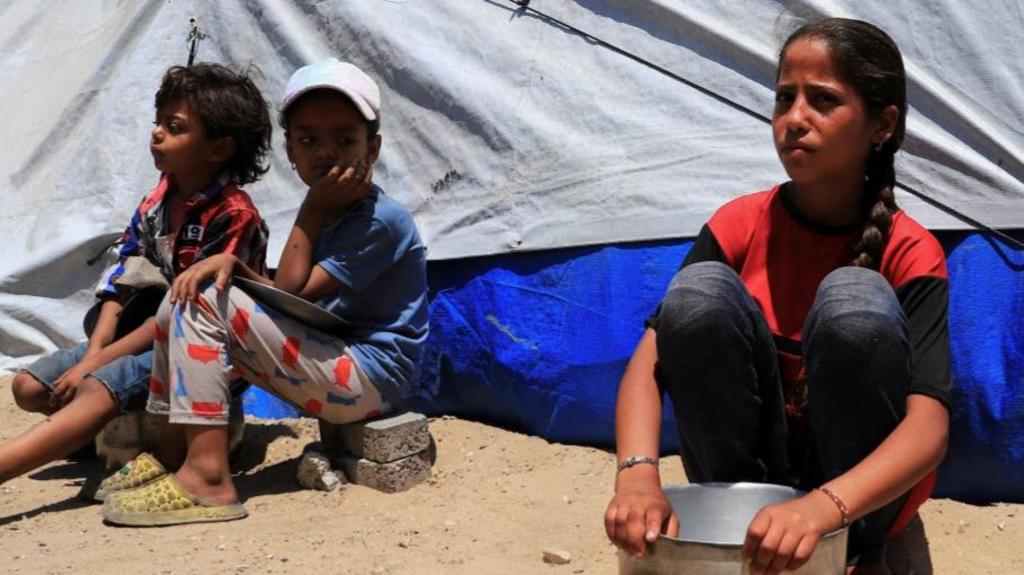Report on the Humanitarian Crisis in Gaza and its Impact on Sustainable Development Goals
Executive Summary
A severe humanitarian crisis is unfolding in Gaza, characterized by acute food shortages, widespread malnutrition, and a collapsing health system. This situation represents a catastrophic failure to meet key United Nations Sustainable Development Goals (SDGs), particularly SDG 2 (Zero Hunger) and SDG 3 (Good Health and Well-being). The crisis, driven by ongoing military conflict and severe restrictions on humanitarian aid, has led to famine conditions and a rising death toll, necessitating an urgent international response to uphold the principles of the 2030 Agenda for Sustainable Development.
SDG 2: Zero Hunger – A State of Famine
The situation in Gaza directly contravenes the core objective of SDG 2, which aims to end hunger, achieve food security, improve nutrition, and promote sustainable agriculture. Reports from the Integrated Food Security Phase Classification (IPC) confirm that the worst-case scenario of famine is materializing.
Key Indicators of Failure for SDG 2:
- Widespread Starvation: Medical professionals and aid organizations report an increasing number of deaths from malnutrition, with dozens dying in recent weeks.
- Critical Food Scarcity: A crippling lack of food has led to spiraling costs for available supplies, placing essential nutrition entirely out of reach for the vast majority of the population.
- Expert Confirmation: International experts, including Jeremy Konyndyk of Refugees International, have identified a “tipping point,” noting that the emergence of starvation-related deaths indicates a severely deprived population on the brink of mass mortality.
SDG 3: Good Health and Well-being – A Health System in Collapse
The crisis has precipitated a massive health disaster, undermining every aspect of SDG 3, which seeks to ensure healthy lives and promote well-being for all at all ages. The direct and indirect impacts on the population’s health are severe and long-lasting.
Impact on Health and Well-being:
- Rising Child Mortality: The Palestinian health ministry reports that 154 people have died from starvation, including 89 children. Pediatric specialists on the ground confirm daily deaths of children from malnutrition, a direct setback to SDG 3’s target of ending preventable deaths of newborns and children under 5.
- Long-Term Health Consequences: Health experts warn that children surviving the current hunger crisis will suffer permanent health impacts. Malnutrition at this scale causes stunting and developmental issues, meaning “their little bodies are shutting down,” which will have lifelong consequences.
- Overwhelmed Medical Facilities: Hospitals are overwhelmed with a spike in admissions of children and infants for malnutrition, while medical staff are themselves overworked and underfed, crippling the capacity to provide adequate care.
SDG 16: Peace, Justice and Strong Institutions – Barriers to Aid and Safety
The fundamental driver of the crisis is the failure to achieve SDG 16, which promotes peaceful and inclusive societies. The ongoing conflict and restrictions on humanitarian access prevent the establishment of peace and the functioning of just institutions.
Challenges to Peace and Humanitarian Access:
- Crippling Aid Restrictions: Despite growing international outrage, aid restrictions remain the primary barrier to alleviating the crisis. Aid officials have stated that limited pauses in fighting are insufficient to deliver the necessary volume of supplies.
- Lack of Safe Access: The inability to safely access food and adequate health services, as noted by public health scientists, is a direct result of the conflict, preventing any progress toward stability and well-being.
- Data Collection Impeded: The difficulty in gathering accurate data on mortality and malnutrition, due to access restrictions, hinders a fully effective humanitarian response and accountability, highlighting a breakdown of the systems envisioned in SDG 16.
SDGs Addressed in the Article
- SDG 2: Zero Hunger – The article’s central theme is the critical lack of food, spiraling food costs, malnutrition, and the onset of famine in Gaza.
- SDG 3: Good Health and Well-being – The text highlights a “massive health disaster,” deaths from malnutrition (especially among children), and the long-term health impacts of the hunger crisis.
- SDG 16: Peace, Justice and Strong Institutions – The article identifies the “deadly military offensive” and “crippling aid restrictions” as the root causes of the hunger and health crises, pointing to the breakdown of peace and security.
Specific SDG Targets Identified
-
SDG 2: Zero Hunger
- Target 2.1: By 2030, end hunger and ensure access by all people, in particular the poor and people in vulnerable situations, including infants, to safe, nutritious and sufficient food all year round.
The article directly addresses this by describing the “critical lack of food,” the “spiraling cost of the little that was available,” and the warning from the Integrated Food Security Phase Classification (IPC) that a “worst-case scenario of famine” is unfolding. - Target 2.2: By 2030, end all forms of malnutrition, including achieving, by 2025, the internationally agreed targets on stunting and wasting in children under 5 years of age, and address the nutritional needs of adolescent girls, pregnant and lactating women and older persons.
This target is relevant as the article repeatedly mentions deaths from malnutrition, particularly in children. Dr. Ahed Jabr Khalaf states that “several more children had died from malnutrition,” and there has been a “spike in the number of children and infants who are being admitted to the hospital for malnutrition.”
- Target 2.1: By 2030, end hunger and ensure access by all people, in particular the poor and people in vulnerable situations, including infants, to safe, nutritious and sufficient food all year round.
-
SDG 3: Good Health and Well-being
- Target 3.2: By 2030, end preventable deaths of newborns and children under 5 years of age.
The article directly relates to this target by reporting that “154 people had died from starvation since the war began, including 89 children” and that children’s “little bodies are shutting down.” - Target 3.8: Achieve universal health coverage, including financial risk protection, access to quality essential health-care services and access to safe, effective, quality and affordable essential medicines and vaccines for all.
The article implies a failure to meet this target by describing a “massive health disaster” and the need for the population to “safely access food and adequate health services” to prevent the situation from worsening.
- Target 3.2: By 2030, end preventable deaths of newborns and children under 5 years of age.
-
SDG 16: Peace, Justice and Strong Institutions
- Target 16.1: Significantly reduce all forms of violence and related death rates everywhere.
The article identifies the “deadly military offensive” as a primary cause of the crisis. The resulting deaths from starvation are a direct consequence of this violence, which has also led to “crippling aid restrictions,” preventing humanitarian relief.
- Target 16.1: Significantly reduce all forms of violence and related death rates everywhere.
Indicators for Measuring Progress
-
Indicators for SDG 2 (Zero Hunger)
- Prevalence of undernourishment: The Integrated Food Security Phase Classification (IPC) report sounding the alarm about a “worst-case scenario of famine” serves as a direct indicator.
- Prevalence of malnutrition (wasting and stunting) in children under 5 years of age: The article mentions a “spike in the number of children and infants who are being admitted to the hospital for malnutrition” and reports of “multiple deaths from starvation.”
-
Indicators for SDG 3 (Good Health and Well-being)
- Under-5 mortality rate and Neonatal mortality rate: The data provided by the Palestinian health ministry serves as a direct indicator: “154 people had died from starvation since the war began, including 89 children.” The daily updates of this tally are a mechanism for tracking this indicator.
-
Indicators for SDG 16 (Peace, Justice and Strong Institutions)
- Number of civilian deaths in armed conflict: The article’s reference to the “deadly military offensive” and the resulting deaths from starvation are indicators of the human cost of the conflict.
- Proportion of the population subjected to physical, psychological or sexual violence: The widespread starvation and health crisis resulting from “crippling aid restrictions” can be considered a form of violence inflicted upon the civilian population.
SDGs, Targets, and Indicators Analysis
| SDGs | Targets | Indicators |
|---|---|---|
| SDG 2: Zero Hunger |
2.1: End hunger and ensure access to safe, nutritious and sufficient food.
2.2: End all forms of malnutrition. |
– Integrated Food Security Phase Classification (IPC) report warning of famine. – “Critical lack of food” and “spiraling cost” of available food. – Reports of a “spike in the number of children and infants who are being admitted to the hospital for malnutrition.” |
| SDG 3: Good Health and Well-being |
3.2: End preventable deaths of newborns and children under 5 years of age.
3.8: Achieve universal health coverage and access to quality essential health-care services. |
– Daily death tally from the Palestinian health ministry (e.g., “154 people had died from starvation… including 89 children”). – Reports of a “massive health disaster.” – Lack of safe access to “adequate health services.” |
| SDG 16: Peace, Justice and Strong Institutions | 16.1: Significantly reduce all forms of violence and related death rates everywhere. |
– Existence of a “deadly military offensive.” – Imposition of “crippling aid restrictions” preventing humanitarian access. – Deaths from starvation as a direct result of the conflict and aid blockade. |
Source: nbcnews.com






